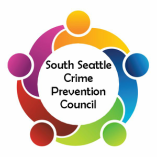South Precinct Map & Boundaries
The South Seattle Crime Prevention Council (SSCPC) believes that it is important for people to have a basic knowledge of the area of the South Precinct and how this area compares to the other four Seattle Police precincts (East, North, Southwest, and West).
The Lay of the Land: Topography of the South Precinct
Our precinct, the South Precinct, is defined by the area from I-90 (roughly, the precinct's northern boundary) to Seattle's City Limits (southern boundary), and from the Duwamish Waterway (western boundary) to Lake Washington (eastern boundary).
Unlike other parts of Seattle, many south Seattle streets and roads were not established in a grid pattern, resulting in a limited number of north-south and east-west corridors. The small number of east-west and north-south corridors make traveling through the South Precinct challenging for police officers.
Driving one of the few north-south corridors, Martin Luther King, Jr. Way South, has been problematized by the at-grade, street-level tracks of Sound Transit's Link Light Rail. The sole east-west corridor which extends through most (yet not all) of our precinct is Othello/Myrtle. Othello/Myrtle has undergone the elimination of one lane of traffic, in each direction, a practice called a road diet; further, bike lanes have been added. Unfortunately, the changes to the Othello/Myrtle corridor has affected easy navigability of this major east-west thoroughfare for emergency vehicles.
The Challenges of Policing in the South Precinct
The South Precinct includes all of the 98118 zip code, among the most culturally and ethnically/racially diverse zip codes in the US, and parts of zip code areas 98178, 98108, 98134, and 98144. The areas served by the South Precinct are enjoyable because of this diversity yet the very element which makes our community so special poses complex challenges to our police officers: Due to the many languages spoken in our neighborhood and the many cultural customs/practices, it often takes police extra effort and time to gather case information. Also, a number of us may be hesitant about contacting police out of concerns such as "disloyalty" or fear of shaming or retaliation.
Additionally, our south Seattle community is unfortunately penalized for the diversity many of us treasure. Police personnel/resources are allocated to precincts based on the volume of telephone calls placed to 9-1-1. For a variety of reasons, some explained above, people in our community do not call 9-1-1 as much as people in other Seattle police precincts. Based upon several door-to-door surveys conducted by concerned community members, only 10-25% of all crimes in the South Precinct are reported to the police. The South Seattle Crime Prevention Council (SSCPC) wants safe and enjoyable places in which our residents can live, play, and work; our community's livability--and the police's ability to serve and protect us--is deleteriously affected by the underreporting of crime. The SSCPC encourages people in our community to report crimes and concerns to the police department; please see the Reporting Crimes tab on our website for more information.
Our precinct, the South Precinct, is defined by the area from I-90 (roughly, the precinct's northern boundary) to Seattle's City Limits (southern boundary), and from the Duwamish Waterway (western boundary) to Lake Washington (eastern boundary).
Unlike other parts of Seattle, many south Seattle streets and roads were not established in a grid pattern, resulting in a limited number of north-south and east-west corridors. The small number of east-west and north-south corridors make traveling through the South Precinct challenging for police officers.
Driving one of the few north-south corridors, Martin Luther King, Jr. Way South, has been problematized by the at-grade, street-level tracks of Sound Transit's Link Light Rail. The sole east-west corridor which extends through most (yet not all) of our precinct is Othello/Myrtle. Othello/Myrtle has undergone the elimination of one lane of traffic, in each direction, a practice called a road diet; further, bike lanes have been added. Unfortunately, the changes to the Othello/Myrtle corridor has affected easy navigability of this major east-west thoroughfare for emergency vehicles.
The Challenges of Policing in the South Precinct
The South Precinct includes all of the 98118 zip code, among the most culturally and ethnically/racially diverse zip codes in the US, and parts of zip code areas 98178, 98108, 98134, and 98144. The areas served by the South Precinct are enjoyable because of this diversity yet the very element which makes our community so special poses complex challenges to our police officers: Due to the many languages spoken in our neighborhood and the many cultural customs/practices, it often takes police extra effort and time to gather case information. Also, a number of us may be hesitant about contacting police out of concerns such as "disloyalty" or fear of shaming or retaliation.
Additionally, our south Seattle community is unfortunately penalized for the diversity many of us treasure. Police personnel/resources are allocated to precincts based on the volume of telephone calls placed to 9-1-1. For a variety of reasons, some explained above, people in our community do not call 9-1-1 as much as people in other Seattle police precincts. Based upon several door-to-door surveys conducted by concerned community members, only 10-25% of all crimes in the South Precinct are reported to the police. The South Seattle Crime Prevention Council (SSCPC) wants safe and enjoyable places in which our residents can live, play, and work; our community's livability--and the police's ability to serve and protect us--is deleteriously affected by the underreporting of crime. The SSCPC encourages people in our community to report crimes and concerns to the police department; please see the Reporting Crimes tab on our website for more information.


